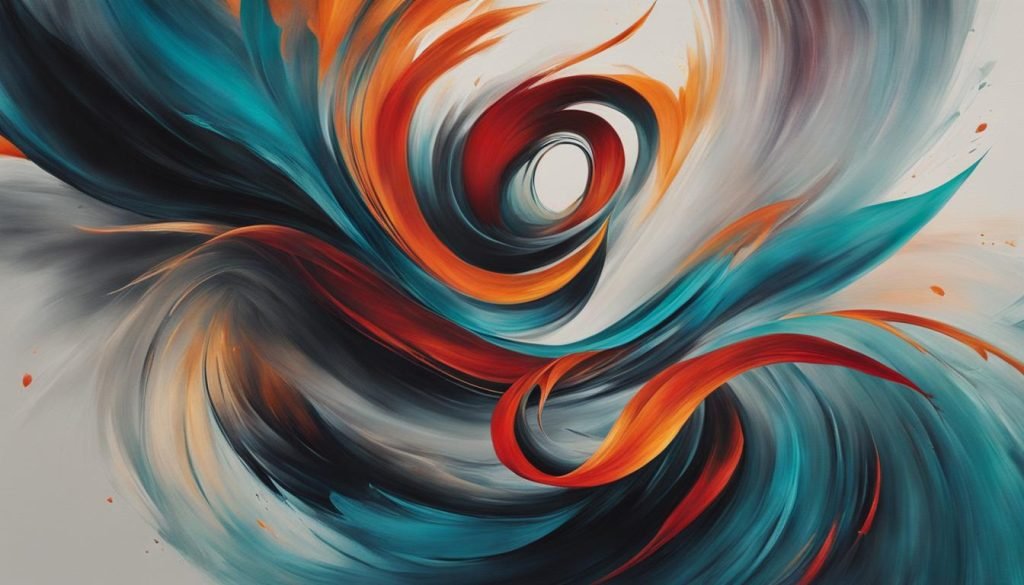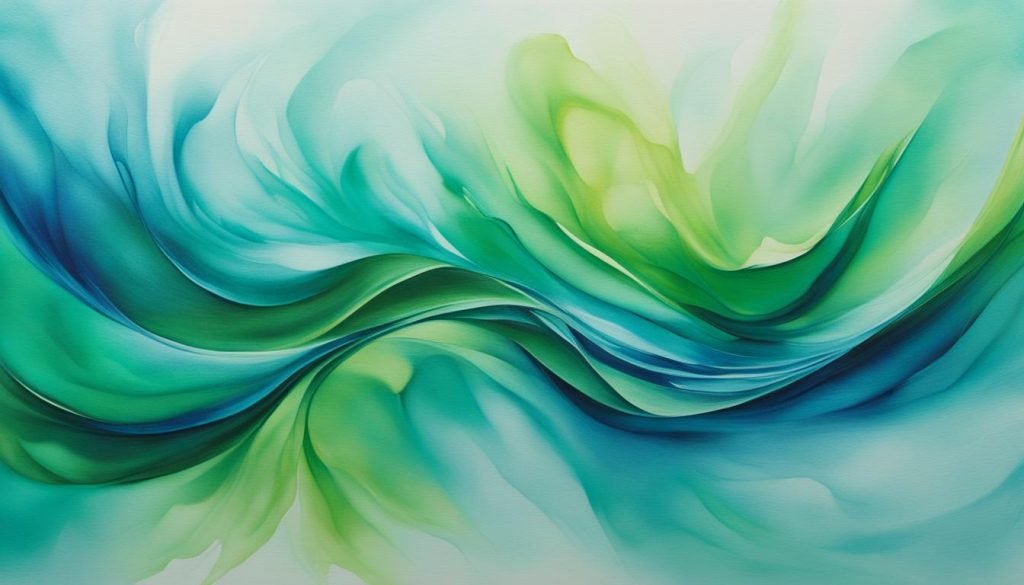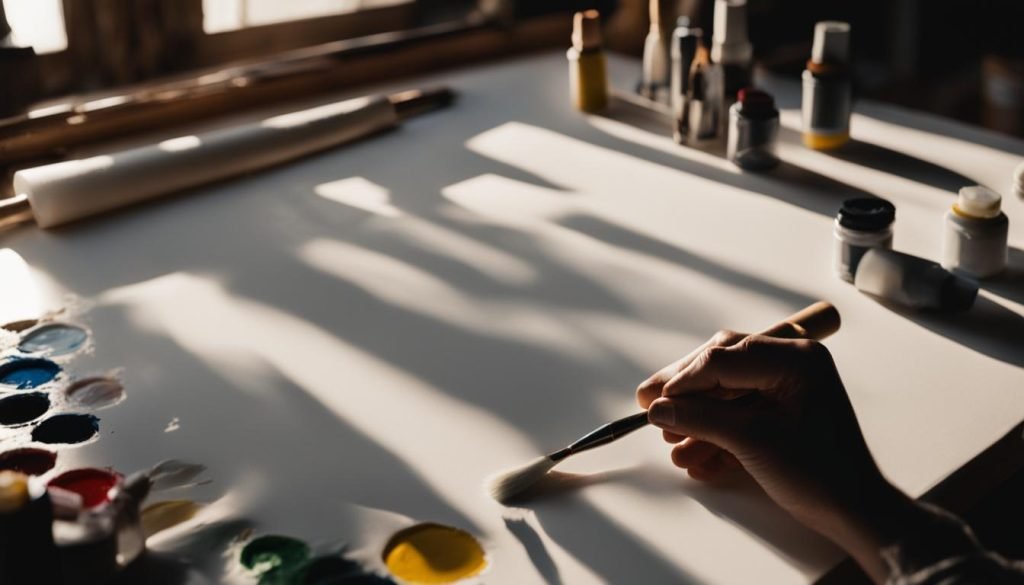Calligraphy on Canvas Secrets: Transform Your Art with These Amazing Tips!
Are you ready to dive into the world of calligraphy on canvas and unleash your artistic talent? Whether you’re a beginner or an experienced artist, calligraphy on canvas offers a unique and powerful form of creative expression. With a variety of techniques and tools at your disposal, you can create stunning and meaningful artwork that showcases your individual style and vision.
Canvas art has long been revered for its ability to captivate and inspire. By combining the elegance of calligraphy with the versatility of canvas, you can take your artistic journey to new heights. From brush strokes to script styles, and from canvas preparation to framing techniques, there’s so much to explore and learn.
Key Takeaways:
- Calligraphy on canvas allows you to unleash your artistic talent and express yourself creatively.
- The combination of calligraphy and canvas art offers a powerful form of personal expression.
- Canvas preparation, brush selection, and script styles play a crucial role in creating stunning calligraphy on canvas.
- Preserving and displaying your calligraphy on canvas requires careful framing and protection.
- Whether you’re a beginner or an advanced artist, there are resources available to help you enhance your calligraphy skills.
Express Yourself with Calligraphy on Canvas

Calligraphy on canvas is an art form that allows you to tap into your personal expression, authenticity, and emotional release. It provides a unique platform for conveying your innermost thoughts and feelings through the strokes of a brush. By immersing yourself in the creative process, you can create artwork that truly reflects who you are.
Unlike other art forms, calligraphy on canvas offers a cathartic experience. It allows you to channel your emotions into your work, providing a therapeutic outlet for self-expression. Whether you’re feeling overwhelmed, happy, or reflective, calligraphy on canvas can serve as a powerful tool for processing and communicating your emotions.
Through calligraphy on canvas, you have the opportunity to dive deep within yourself, exploring the depths of your creativity and unleashing your artistic potential. It’s a chance to embrace your authenticity and showcase your unique perspective to the world. As you create each stroke, you infuse your artwork with your personal touch, making every piece a reflection of your individuality.
So, grab your brushes, choose your canvas, and let your innermost thoughts and feelings flow onto the page. Allow calligraphy on canvas to be your medium of self-expression, your avenue for authenticity, and your pathway to emotional release. The possibilities are endless, and the journey awaits.
Table: Benefits of Calligraphy on Canvas
| Benefits | Description |
|---|---|
| Personal Expression | Provides a means to express your thoughts and emotions. |
| Authenticity | Allows you to showcase your unique voice and style. |
| Emotional Release | Offers a cathartic experience to channel your emotions. |
| Innermost Thoughts and Feelings | Provides a platform for exploring and sharing your deepest thoughts and feelings. |
Tools and Techniques for Calligraphy on Canvas
Before you embark on your calligraphy journey on canvas, it’s essential to understand the tools and techniques that will help you create stunning artwork. Proper canvas preparation techniques, the right calligraphy-specific brushes, waterproof calligraphy inks, flexible nibs, and effective canvas sealing techniques are all crucial elements to consider. Let’s dive into each of these aspects in detail:
Canvas Preparation Techniques
Preparing your canvas properly is the first step towards creating beautiful calligraphy artwork. Priming the canvas with gesso creates a smooth surface that is ideal for calligraphy. Gesso helps prevent the paint from seeping through the fibers of the canvas, ensuring crisp and clean lines in your calligraphy. Take your time to apply a sufficient layer of gesso and let it dry completely before starting your artwork.
Calligraphy-Specific Brushes and Flexible Nibs
Using the right tools is essential for achieving precise and flowing strokes in calligraphy on canvas. Calligraphy-specific brushes are designed with a specific shape and bristle density that allow for greater control and versatility. Flexible nibs are also invaluable tools that provide smooth and consistent ink flow, enabling you to create various line thicknesses and beautiful letterforms.
Waterproof Calligraphy Inks
To ensure the longevity of your calligraphy on canvas, it’s important to use waterproof calligraphy inks. These inks are specially formulated to resist fading, smudging, and running when exposed to moisture or accidental spills. By choosing waterproof inks, you can have confidence that your artwork will remain vibrant and protected over time.
Canvas Sealing Techniques
Sealing your calligraphy on canvas helps protect the artwork from dust, dirt, and other environmental elements. There are several canvas sealing techniques you can consider, such as applying a clear acrylic varnish or using a protective spray. These sealants not only safeguard your artwork but also enhance its overall appearance, giving it a professional and polished finish.
By familiarizing yourself with these tools and techniques, you’ll be well-equipped to unleash your artistic potential and create captivating calligraphy on canvas.
Exploring Calligraphy Script Styles for Canvas

When it comes to calligraphy on canvas, one of the most exciting aspects is the ability to experiment with different script styles. This allows you to add a unique touch to your artwork and showcase your creativity. Whether you prefer traditional scripts like Copperplate and Spencerian or more contemporary styles like Modern Calligraphy, the options are endless. Each script style has its own characteristics, such as the shape of the letters, the angle of the strokes, and the overall flow of the script. By exploring and mastering different calligraphy script styles, you can create captivating compositions that truly stand out.
To bring your calligraphy on canvas to life, it’s important to have the right tools. Brush pens are a popular choice, as they provide versatility in line variation and offer expressive strokes. They are especially useful for creating thick and thin strokes, which can add depth and dimension to your calligraphy. Additionally, brush pens come in various sizes and types, allowing you to experiment with different effects and styles. Another tool to consider is metallic inks. These can add a touch of glamour and shimmer to your calligraphy, making it visually captivating. Whether you want to create elegant gold accents or vibrant copper details, metallic inks can elevate your artwork.
Watercolor calligraphy is another technique that can enhance the beauty of your calligraphy on canvas. By using watercolor paints instead of traditional ink, you can achieve a softer and more ethereal look. Watercolor calligraphy allows for unique color blending and transparency, creating a mesmerizing effect on the canvas. It offers a wide range of possibilities in terms of color combinations and gradients, allowing you to create stunning and dreamy compositions. Whether you choose to incorporate watercolor calligraphy as the main focus or as subtle accents in your artwork, it adds a captivating and artistic touch.
Calligraphy Script Styles Comparison
| Script Style | Characteristics | Usage |
|---|---|---|
| Copperplate | Elegant and flowing script with thick and thin strokes. | Formal invitations, certificates, and wedding stationery. |
| Spencerian | Gentle and graceful script with an emphasis on curves and loops. | Personal correspondence, quotes, and poetry. |
| Modern Calligraphy | Contemporary script with varied letterforms and freedom in composition. | Art prints, signage, and creative projects. |
As you explore different calligraphy script styles for canvas, remember to experiment, play with different tools and techniques, and let your creativity guide you. The beauty of calligraphy on canvas lies in the ability to create unique and personalized artwork that reflects your own style. So, whether you choose to delve into the elegance of Copperplate, embrace the grace of Spencerian, or explore the contemporary vibes of Modern Calligraphy, let your imagination flow freely and enjoy the journey of creating stunning calligraphy on canvas.
References:
- “Calligraphy Styles and Examples – Brush Lettering Guide.” The Postman’s Knock, https://thepostmansknock.com/calligraphy-styles/. Accessed 24 September 2023.
- “Watercolor Calligraphy for Beginners.” The Happy Ever Crafter, https://www.thehappyevercrafter.com/blog/watercolor-calligraphy-for-beginners/. Accessed 24 September 2023.
- “Calligraphy Script Styles for Beginners.” Calligraphy.org, https://www.calligraphy.org/calligraphy-information/calligraphy-script-styles/. Accessed 24 September 2023.
Preserving and Displaying Your Calligraphy on Canvas
Once you’ve created your stunning calligraphy on canvas, it’s essential to preserve and display it properly to ensure its longevity and showcase its beauty. Here are some important considerations for preserving and displaying your calligraphy on canvas:
Canvas Framing Methods
To give your calligraphy on canvas a polished and professional look, framing is a popular option. There are various framing methods you can choose from, depending on your aesthetic preferences and the style of your artwork. Some common framing methods include:
- Floating Frame: This method involves mounting the canvas within a frame, allowing the edges of the canvas to be visible, creating a modern and minimalistic look.
- Stretching Over a Wooden Frame: This method involves stretching the canvas tightly over a wooden frame, creating a traditional and classic look.
Consider the style and size of your artwork when choosing the framing method that best suits your calligraphy on canvas.
Protective Varnishes
To safeguard your calligraphy on canvas from dust, UV rays, and other potential damage, applying a protective varnish is crucial. A varnish acts as a protective barrier, sealing the surface of the canvas and enhancing its durability. It also adds a glossy or matte finish to your artwork, enhancing its overall appearance. When applying a varnish, ensure that your calligraphy is fully dry, and follow the manufacturer’s instructions for best results.
Canvas Hanging Hardware
When it comes to displaying your calligraphy on canvas, using appropriate hanging hardware is essential to ensure stability and prevent any potential damage. Depending on the weight and size of your canvas, you may need to consider different hanging hardware options, such as:
- Picture Hanging Hooks: These hooks are designed specifically for hanging artwork and provide secure support for your calligraphy on canvas.
- Wall Anchors and Screws: If you have a heavier canvas, using wall anchors and screws can offer added stability and support.
Ensure that the hanging hardware you use is suitable for the type of wall you’re hanging your calligraphy on canvas on, such as drywall, concrete, or wood.
Art Display Options
Aside from traditional framing, you can explore various creative art display options to showcase your calligraphy on canvas:
- Gallery Wall: Create a captivating gallery wall by displaying multiple calligraphy pieces together, allowing them to complement and enhance each other.
- Art Easel: Consider placing your calligraphy on an art easel, allowing it to stand freely and make a statement in any space.
Experiment with different display options to find the one that best highlights your calligraphy on canvas and complements your artistic vision.
| Framing Methods | Pros | Cons |
|---|---|---|
| Floating Frame | – Modern and minimalistic look – Allows the edges of the canvas to be visible |
– May not be suitable for all calligraphy styles – Requires careful sizing and positioning |
| Stretching Over a Wooden Frame | – Traditional and classic look – Provides a taut and sturdy surface |
– Edges of the canvas are covered – Requires proper tensioning and stretching |
Calligraphy on Canvas for Beginners and Advanced Artists

Whether you’re a beginner or an advanced artist, there are resources available to help you enhance your calligraphy on canvas skills. Online tutorials provide step-by-step guidance on creating different calligraphy styles and techniques. Practice templates can help you improve your letterforms and develop consistency in your strokes. Hand-lettering tips offer valuable advice on composition, spacing, and layout for your calligraphy on canvas. For advanced artists, exploring more complex calligraphy techniques, such as flourishing and blending, can take your artwork to the next level. The key is to practice regularly and continue learning to refine your calligraphy skills.
Learning calligraphy on canvas can seem intimidating at first, but with the right tools and guidance, you can develop your skills and create stunning artworks. Online tutorials provide an accessible way to learn calligraphy from the comfort of your own home. These tutorials cover various topics, from basic strokes and letterforms to more advanced techniques like shading and embellishments. They often include video demonstrations, step-by-step instructions, and practice exercises to help you progress at your own pace.
“Practice makes perfect.” – Anonymous
Calligraphy practice templates are an excellent resource for beginners and experienced artists alike. These templates feature guidelines and lettering samples that you can trace or use as a reference for practicing different calligraphy styles. They help you develop muscle memory, improve your penmanship, and gain a better understanding of letterforms and their proportions. You can find printable practice templates online or invest in a calligraphy workbook that provides a variety of templates for different scripts and lettering styles.
Hand-lettering tips are valuable for creating visually appealing and harmonious compositions. These tips cover aspects such as selecting the right tools and materials, understanding spacing and layout, creating a visually balanced design, and adding decorative elements. By following these tips, you can create calligraphy on canvas that is not only beautiful but also captivating to the viewer. Remember to experiment and explore your own unique style to make your calligraphy on canvas truly distinctive.
Inspiration and Creativity Boosters for Calligraphy on Canvas

If you’re looking for inspiration and ways to boost your creativity for calligraphy on canvas, there are several techniques you can try. Incorporating inspirational quotes into your artwork can add depth and meaning to your calligraphy. Experimenting with different calligraphy compositions, such as lettering in different shapes or creating layered effects, can also spark new ideas. Blending mediums, like watercolor or acrylics, can add visual interest and dimension to your calligraphy on canvas. Using calligraphy-themed stencils can provide structure and help you create intricate designs. Finally, attending creative workshops or online classes can expose you to new techniques and perspectives, fueling your artistic growth.
“Creativity is contagious. Pass it on.” – Albert Einstein
One way to find inspiration for your calligraphy on canvas is to incorporate meaningful quotes into your artwork. Quotes can evoke emotions and provide a starting point for your creative process. Whether it’s a motivational quote, a line from your favorite poem, or words of wisdom from a role model, these quotes can guide the theme and tone of your calligraphy piece.
Calligraphy Composition
Experimenting with different calligraphy compositions can also ignite your creativity. Instead of traditional linear layouts, try lettering in shapes that reflect the meaning of the quote or the message you want to convey. You can create circular compositions for unity, flowing compositions for movement, or asymmetrical compositions for a dynamic effect. By playing with composition, you can add another layer of visual interest to your calligraphy on canvas.
Blending Mediums
Using different mediums in your calligraphy on canvas can add depth and texture to your artwork. Consider incorporating watercolors or acrylic paints to create beautiful washes or gradients behind your calligraphy. Experiment with different blending techniques to achieve smooth transitions and captivating color combinations. The use of different mediums can enhance the overall visual impact of your calligraphy on canvas.
Calligraphy-themed Stencils
If you want to add intricate designs to your calligraphy on canvas but struggle with freehand drawing, calligraphy-themed stencils can be a game-changer. These stencils come in various shapes and patterns, allowing you to create detailed backgrounds or embellishments with ease. By using stencils, you can achieve professional-looking designs and elevate the visual impact of your calligraphy.
Creative Workshops
Attending creative workshops or online classes can provide you with new techniques, insights, and inspiration for your calligraphy on canvas. These workshops often offer hands-on demonstrations, expert guidance, and opportunities to connect with fellow artists. By immersing yourself in a creative community, you can expand your artistic horizons, learn from others, and discover new ways to express yourself through calligraphy on canvas.
| Inspiration and Creativity Boosters | Description |
|---|---|
| Incorporating Inspirational Quotes | Add depth and meaning to your calligraphy by incorporating meaningful quotes into your artwork. |
| Calligraphy Composition | Experiment with different compositions to create visually engaging and unique calligraphy on canvas. |
| Blending Mediums | Add depth and texture to your calligraphy by incorporating watercolors or acrylic paints. |
| Calligraphy-themed Stencils | Use stencils to create intricate designs and patterns in your calligraphy on canvas. |
| Creative Workshops | Attend workshops or online classes to learn new techniques and gain inspiration from fellow artists. |
Optimizing Your Calligraphy Workspace and Techniques
Creating calligraphy on canvas is a rewarding and immersive experience, and optimizing your workspace and techniques can enhance your artistic journey. By paying attention to key elements such as canvas size selection, paint palette organization, calligraphy pen cleaning, canvas lighting, and using non-fading inks, you can create a comfortable and efficient environment that allows your creativity to flourish.
Canvas Size Selection
When choosing a canvas for your calligraphy artwork, consider the size that best suits your desired composition and display space. A larger canvas allows for more intricate details and larger letterforms, while a smaller canvas may be more suitable for a minimalist or intimate piece. Take into account the space where you plan to hang or display your artwork and choose a canvas size that complements the surroundings.
Paint Palette Organization
Organizing your paint palette is essential for efficient color mixing and application. Use a palette with separate compartments for different colors to avoid muddying or contaminating the pigments. Arrange your colors in a logical order and clean the palette regularly to prevent color contamination. This will ensure that your calligraphy on canvas is executed with precision and clarity.
Calligraphy Pen Cleaning
Maintaining clean calligraphy pens is crucial for optimal performance and longevity. After every use, clean your pens thoroughly with water or a recommended cleaning solution to remove any residual ink. Proper cleaning prevents clogging and ensures smooth and consistent ink flow, allowing you to create crisp, flawless calligraphy on canvas.
Canvas Lighting
Proper lighting is essential for accurate color perception and detail work in calligraphy on canvas. Natural light is the best option, so position your workspace near a window or use daylight-simulating bulbs. Avoid harsh or uneven lighting that may cast shadows or distort colors. By ensuring adequate lighting, you can confidently create calligraphy that showcases the full beauty of your chosen inks and color palette.
Non-fading Inks
Choosing non-fading inks is vital for preserving the vibrancy and longevity of your calligraphy on canvas. Look for archival quality inks that are fade-resistant and lightfast. These inks will retain their color intensity over time and ensure that your artwork remains visually striking for years to come. Invest in high-quality inks that are specifically formulated for longevity, allowing you to create calligraphy on canvas that stands the test of time.
| Optimization Factors | Benefits |
|---|---|
| Canvas Size Selection | Choose the right canvas size for your desired composition and display space. |
| Paint Palette Organization | Efficient color mixing and application for precise calligraphy on canvas. |
| Calligraphy Pen Cleaning | Maintain optimal performance and longevity of your calligraphy pens. |
| Canvas Lighting | Ensure accurate color perception and detail work in your calligraphy. |
| Non-fading Inks | Preserve the vibrancy and longevity of your calligraphy on canvas. |
Conclusion
Embarking on the journey of calligraphy on canvas is an invitation to explore your artistic potential, foster personal growth, and express your unique creativity. This captivating art form offers a pathway to self-discovery and a means to communicate your innermost thoughts and emotions.
As you delve into the techniques and tools of calligraphy on canvas, you’ll discover a world of possibilities that allow you to unleash your creative spirit. Whether you’re a novice or an experienced artist, each stroke of the brush becomes a vessel for personal expression and a testament to your artistic voice.
Through calligraphy on canvas, you can tap into your creative potential and witness the transformative power of art. This artistic journey holds the key to personal growth, as you navigate different styles, experiment with compositions, and explore the subtle nuances of letterforms.
So, embrace the art of calligraphy on canvas, let your imagination soar, and watch as your artistic journey unfolds, revealing the boundless depths of your creative potential and the remarkable growth you’ll experience along the way.
FAQ
What is calligraphy on canvas?
Calligraphy on canvas is a form of artistic expression that involves creating beautiful and meaningful artwork using calligraphy techniques on a canvas surface.
Do I need to be an experienced artist to do calligraphy on canvas?
No, calligraphy on canvas can be enjoyed by both beginners and experienced artists. It offers techniques and tools suitable for artists of all skill levels.
How do I prepare the canvas for calligraphy?
Before starting, prime your canvas with gesso to create a smooth surface. This will ensure that the calligraphy flows smoothly and looks its best.
What tools and materials do I need for calligraphy on canvas?
You will need calligraphy-specific brushes, flexible nibs, waterproof calligraphy inks, and acrylic paints. These tools will help you achieve precise and flowing strokes.
Are there different calligraphy script styles for canvas?
Yes, there are various calligraphy script styles to choose from, including traditional scripts like Copperplate and Spencerian, as well as more contemporary styles like Modern Calligraphy.
How can I preserve and display my calligraphy on canvas?
To preserve your artwork, consider sealing it with a protective varnish. When it comes to display, you can frame your canvas using different methods or explore other art display options such as a gallery wall or an art easel.
Are there resources available to enhance my calligraphy on canvas skills?
Yes, there are online tutorials, practice templates, and hand-lettering tips available to help you improve your calligraphy skills and refine your techniques.
How can I boost my creativity for calligraphy on canvas?
You can incorporate inspirational quotes, experiment with different compositions, blend mediums, use calligraphy-themed stencils, and attend creative workshops or online classes to spark new ideas and inspire your artistic growth.
How can I optimize my calligraphy workspace and techniques?
Consider the size of your canvas, organize your paint palette, clean your calligraphy pens and brushes regularly, ensure adequate lighting, and use non-fading inks for vibrant and long-lasting results.
Source Links
- https://medium.com/@maryannthipie/creating-art-from-your-heart-unleashing-your-inner-expression-fe38cb3236ab
- https://www.visitma.com/story/empowering-women-through-art-the-blank-canvas-company-offers-bold-and-bright-designs/
- https://emptyeasel.com/2011/06/13/9-ways-to-boost-your-artistic-creativity/




